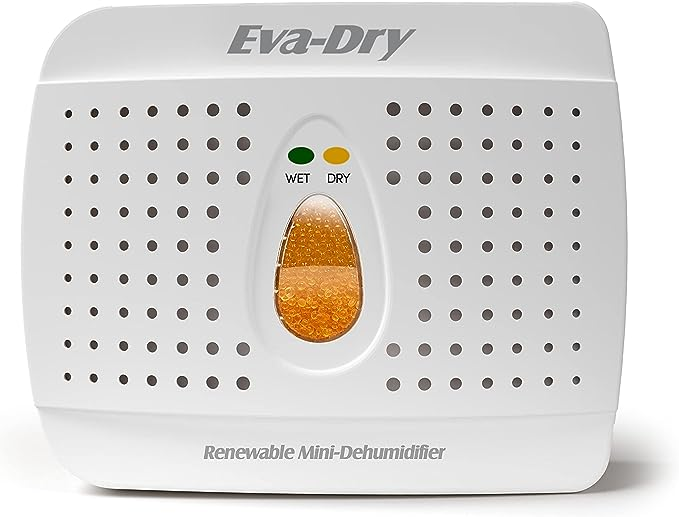
Using a Desiccant Dehumidifier in Your Car: A Detailed Guide
Author: Dave Matthews, Electrical Engineer, Thermair Ltd
Struggling with moisture and humidity in your car can lead to unpleasant odors, driving safety issues and potential damage to your vehicle’s interior. A desiccant dehumidifier could be the solution you need.
In this guide, we will explore what a desiccant dehumidifier is, the causes of moisture in your car, and how to effectively use a dehumidifier to keep your vehicle dry and comfortable.
Discover the benefits of using a car dehumidifier and learn how to choose the right one for your needs.
Key Takeaways:
A desiccant dehumidifier can help remove excess moisture and humidity from your car, preventing mold and mildew growth.
Common causes of moisture and humidity in a car include temperature differences, wet items, and a malfunctioning air conditioning system.
To use a desiccant dehumidifier in your car, place it in a strategic location, choose the right type, and consider using one with rechargeable silica gel for long-term use.
How to Use a Desiccant Dehumidifier in Your Car: A Step-by-Step Guide

Learn how to effectively utilize a desiccant dehumidifier to remove dampness in your car with this comprehensive step-by-step guide. From selecting the right dehumidifier to optimal placement techniques, this guide covers all you need to know to combat excess moisture and prevent condensation buildup in your vehicle.
It’s crucial to choose a desiccant dehumidifier specifically designed for automobile use, ensuring its effectiveness in the confined space of a car.
Once you have your dehumidifier, find a suitable spot in your vehicle for placement – commonly near the footwells or on the dashboard.
Regular maintenance is key to its efficiency, so be sure to check and empty the water collection reservoir frequently to ensure continuous moisture absorption.
By following these steps and incorporating these practices, you can keep your car interior dry, fresh, and free from dampness.
What is a desiccant dehumidifier in car?
A desiccant dehumidifier in a car is a specialized device that utilizes materials like silica gel beads to absorb excess moisture from the car’s interior, helping to prevent issues such as condensation, mold, and mildew.
These desiccant dehumidifiers work by attracting and holding moisture molecules, effectively reducing humidity levels within the car.
One of the key advantages of these devices is their versatility; they can be placed in various spots within the car, such as under seats or in the trunk, to target specific areas prone to moisture buildup.
Desiccant dehumidifiers are particularly useful in climates with high humidity levels or in scenarios where the car is parked for extended periods, minimizing the risk of musty odors and preserving the car’s interior materials.
Temperature Differences Inside and Outside the Car & How to Fix
Understanding the temperature variations present between the inside and outside of the vehicle is crucial in addressing condensation issues.
When the outside temperature drops, the warm interior air can lead to condensation on windows and other surfaces, creating an uncomfortable and potentially hazardous driving environment.
Implementing effective fixes such as using defrosters and setting the air conditioning to the appropriate temperature can help mitigate condensation issues. Utilizing moisture-absorbing products such as silica gel packs or dehumidifiers can aid in regulating the internal climate. By keeping the ventilation system clean and ensuring all seals are intact, you can prevent excess moisture buildup from cold air and maintain a comfortable atmosphere inside the car.
Wet or Moist Car Interior Items & how to fix
Dealing with wet or moist car interior items promptly is essential to prevent moisture damage and the proliferation of mold spores. Learn effective techniques to dry and clean these auto items to avoid potential issues and maintain a healthy car environment.
One crucial aspect to consider when addressing moisture in your car interior is ventilation. Proper airflow can significantly aid in the drying process, aiding in preventing the build-up of excess moisture.
Using absorbent materials such as silica gel packets can help in absorbing residual moisture from surfaces. Placing these packets strategically in your car can assist in the drying process.
Using a mild detergent solution and non-abrasive cloths can be effective in cleaning fabric or leather items without causing damage.
Air Conditioning System Not Working & how to fix
When faced with a cold or malfunctioning air conditioning system in your car, it can lead to increased humidity levels and potential electrical damage.
High humidity levels inside the car not only cause discomfort but can also contribute to the growth of mold and mildew, which pose health risks and degrade air quality. The strain on the electrical components due to a faulty AC system can lead to serious safety issues such as blown fuses, damaged wiring, or even complete system failure.
To troubleshoot these problems, start by checking the AC compressor for any visible damages or leaks. Next, inspect the refrigerant levels and ensure there are no leaks in the system. It’s also essential to examine the cabin air filter and clean or replace it if necessary.
For repairs, consider consulting a professional mechanic to diagnose the root cause of the malfunction accurately. Depending on the issue, repairs may range from simple component replacements to more complex system overhauls. It’s crucial to address AC problems promptly to prevent further damage and maintain a comfortable driving experience.
What Are the Benefits of Using a Car Dehumidifier?
Discover the numerous benefits that utilizing a car dehumidifier can offer, from safeguarding your vehicle against moisture-related issues like mold, mildew, and stains to ensuring a fresh and dry interior environment conducive to both your comfort and car’s longevity.
One of the key advantages of having a car dehumidifier is its ability to maintain optimal humidity levels inside your vehicle, which not only prevents structural damage but also inhibits the growth of harmful microorganisms. By eliminating excess moisture, you significantly reduce the chances of rust formation on metal surfaces and deterioration of electronic components due to corrosion.
Additionally, enhancing air quality within the car through dehumidification helps in mitigating respiratory issues caused by mold spores and bacteria, creating a healthier environment for both short drives and long journeys.
Choosing the Right Car Dehumidifier
Selecting the ideal car dehumidifier involves deciding between electric and non-electric models based on your preferences and requirements.
Electric car dehumidifiers typically run on batteries or require a power source, offering the convenience of consistent moisture removal without the need for regular maintenance. On the other hand, non-electric dehumidifiers utilize moisture-absorbing materials like silica gel or activated charcoal, providing a more eco-friendly option that can be regenerated for reuse.
While electric dehumidifiers are ideal for frequent or long-term use in vehicles with access to power outlets, non-electric models are perfect for those looking for a portable and hassle-free solution. Non-electric dehumidifiers are not as energy-intensive as their electric counterparts, making them a cost-effective and sustainable choice for smaller car spaces.
Electric
Electric car dehumidifiers offer enhanced efficiency and convenience by utilizing a power source to operate continuously, ensuring optimal moisture removal and maintaining a dry interior environment.
One of the standout features of electric car dehumidifiers is their ability to efficiently combat moisture-related issues, safeguarding your vehicle from potential damage caused by humidity. These devices are designed to work seamlessly with the power supply of your car, making them energy-efficient and cost-effective. In addition, the compact size of electric car dehumidifiers allows for easy installation in various vehicle types, without occupying valuable space.
Furthermore, their effectiveness in preventing condensation and mold growth sets them apart as crucial accessories for maintaining a healthy cabin environment.
Non-electric
Non-electric car dehumidifiers offer an eco-friendly and rechargeable alternative for moisture control in vehicles, providing a sustainable solution that can be easily rejuvenated for continuous usage.
These dehumidifiers, which do not rely on electricity, operate through innovative absorbent materials that effectively eliminate moisture from the car interior without the need for power sources.
The absence of electricity not only makes them environmentally-friendly but also ensures energy savings and reduces the carbon footprint in comparison to traditional electric dehumidifiers.
Their rechargeable design allows for long-term use, making them a cost-effective solution that promotes sustainability in automotive care.
Best dehumidifiers for your car

Explore a curated selection of the best dehumidifiers designed specifically for cars, including popular choices like the Eva-dry E-333 Mini Dehumidifier, Smart4u 200g Rechargeable Desiccant Pack, and Wisedry 2 x 500 Gram Silica Gel Car Dehumidifier, known for their effectiveness in combating moisture and enhancing interior air quality.
These top-rated dehumidifiers offer a range of innovative features, from compact designs to eco-friendly materials, catering to diverse consumer preferences. Users praise the Eva-dry E-333 for its whisper-quiet operation, making it ideal for smaller vehicles where noise levels matter. The Smart4u 200g stands out for its rechargeable capability, providing a cost-effective and sustainable solution for long-term use.
Wisedry 2 x 500 Gram model, with its large silica gel capacity, is favored by customers with bigger cars or those facing particularly high humidity levels. User reviews consistently highlight the noticeable difference in air quality and the prevention of mold and mildew growth inside vehicles, making these dehumidifiers essential accessories for any car or truck owner.
Many wonder how car dehumidifiers work and if they are effective in preventing moisture buildup. Understanding the role of silica gel in absorbing dampness inside a vehicle can also be confusing.
To address these concerns, it’s essential to know the various types of dehumidifiers available for cars, such as electric or rechargeable options, and how they function to reduce humidity levels.
Exploring the benefits of incorporating silica gel packets in your car can significantly aid in moisture management and mold prevention.
Best Practices for Storing a Car Dehumidifier
Implementing proper storage practices for your car dehumidifier is essential to maintain its effectiveness and prolong its lifespan. Learn how to store your dehumidifier correctly to prevent issues like condensation buildup and ensure it remains ready for use whenever needed.
When storing a car dehumidifier, it is crucial to place it in a cool, dry location away from direct sunlight or sources of excess heat. Avoid storing it in areas with high humidity levels, such as the bathroom or kitchen, as this can affect its performance. Consider using a sealed plastic container or airtight bag to protect the dehumidifier from dust and moisture when not in use.
Regularly check and clean the dehumidifier’s filter to ensure optimal air flow and efficiency. This simple maintenance task can significantly enhance the unit’s performance and longevity. If your dehumidifier has a tank, make sure to empty it regularly and clean it with a mild detergent to prevent mold or bacteria growth.
Efficient Storage Solutions for Car Dehumidifiers
Discover efficient storage solutions tailored for car dehumidifiers, including options like using airtight containers, silica gel packs, or dedicated storage bags to preserve the granules’ efficacy and prevent moisture damage during storage periods.
By ensuring a snug fit within a sealed airtight container, the car dehumidifier can remain shielded from external moisture, maintaining its optimal functioning over time. Incorporating silica gel packs in the storage setup offers an extra layer of protection by absorbing any residual moisture that might penetrate the container. Likewise, utilizing dedicated storage bags specifically designed for dehumidifiers adds a convenient and protective solution to keep the device safe and ready for future use.
Preventing Leaks and Corrosion with Proper Dehumidifier Storage
Learn how to prevent common issues like leaks and corrosion associated with improper dehumidifier storage by following essential guidelines for protecting your device during periods of non-use. Proper storage techniques can extend the lifespan of your dehumidifier and maintain its effectiveness over time.
One key aspect to consider in safeguarding your dehumidifier is ensuring it is completely dry before storing it. Moisture left in the unit can lead to mold growth and internal damage. To facilitate thorough drying,
Emptying the water reservoir and running the dehumidifier in a well-ventilated area for a few hours is recommended.
Storing your device in a
Cool, dry place away from direct sunlight and extreme temperatures helps prevent corrosion and deterioration of internal components.
Frequently Asked Questions
1. What is a desiccant dehumidifier and how does it work in a car?
A desiccant dehumidifier is a small device that helps remove excess moisture and humidity from the air in your car. It works by using a desiccant material, such as silica gel, to absorb all the moisture out from the air and trap it within the device.
2. How can I tell if my car needs a desiccant dehumidifier?
If you notice a musty or damp smell in your car, foggy windows, or any signs of mold or mildew, it is likely an indicator that your car has excess moisture and could benefit from a desiccant dehumidifier.
3. Can I use a desiccant dehumidifier in any type of car?
Yes, desiccant dehumidifiers are suitable for use in all types of cars, including sedans, SUVs, and trucks. They are also safe to use in both new and older model cars.
4. How do I use a desiccant dehumidifier in my car?
First, make sure to read the instructions provided with your specific desiccant dehumidifier. Generally, you will place the device in a cup holder or on the dashboard, and allow it to absorb moisture from the air for a certain period of time before recharging or replacing the desiccant material.
5. How often do I need to replace or recharge the desiccant material in my dehumidifier?
The frequency of replacement or recharging will depend on the humidity levels in your area and how often you use your car. It is recommended to check and replace or recharge the desiccant material every few weeks or when you notice it is no longer absorbing moisture effectively.
6. Can a desiccant dehumidifier help prevent damage to my car?
Yes, using a desiccant dehumidifier can help prevent damage from excess moisture and humidity in your car. It can help prevent mold and mildew growth, musty odors, and even damage to electronic components in your car.